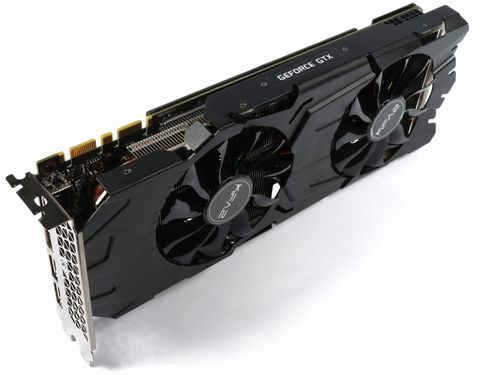Early Verdict
KFA2/Galax's GeForce GTX 1080 Ti EXOC is a sensible card with a dual-slot thermal solution that works well in smaller (well-ventilated) cases. It won't set any overclocking records due to limited cooling capacity, but it's still fairly quiet. Either you need to be content with its well-chosen factory settings or suffer increased noise if you choose to push for higher frequencies.
Pros
- +
Dual-slot form factor
- +
Attractive price point
- +
Faster and quieter than Founders Edition card
Cons
- -
Limited overclocking headroom
- -
Poor availability
- -
Modest default clock rates
Why you can trust Tom's Hardware
Features & Specifications
In contrast to EVGA's aggressively overclocked GeForce GTX 1080 Ti FTW3 Gaming, KFA2/Galax emphasizes sensible, middle-of-the-road decisions with its GeForce GTX 1080 Ti EXOC. As a result, two fans should be plenty for this dual-slot card. And in the end, despite a high-end GP102 processor, the EXOC's understated design adds a certain amount of charm.
The GeForce GTX 1080 Ti EXOC's specifications are closely related to Nvidia's Founders Edition model. It does, however, try to incorporate quieter cooling. As we'll see, it is possible to improve on the original GeForce GTX 1080 Ti's performance with little more than slightly lower temperatures.
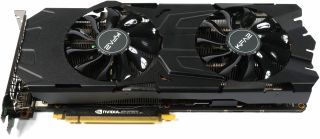
Since the actual performance of any third-party card depends on the GPU Boost frequency it can sustain, and thus on cooling, power limits, and processor quality, any review that relies on bar charts is little more than a snapshot of a single specimen. That's why we're putting our emphasis on the actual implementation of each model. To that end, a lot of equipment goes into thoroughly documenting a graphics card's behaviors. If you'd like a peek at what goes into such an evaluation, check out our Nvidia GeForce GTX 1080 Ti 11GB Review. It makes for a good baseline on which KFA2/Galax builds.
Specifications
Unboxing, Dimensions & Interfaces
The GeForce GTX 1080 Ti EXOC is almost petite among the 1080 Tis we've reviewed already. Weighing in at just 976 grams, it's almost 500 grams lighter than the beefiest board in our lab.
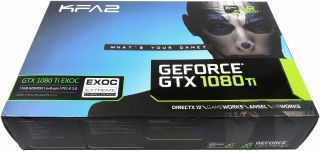
A length of 27.8cm from the slot bracket's outer edge to the shroud's back, a height of 11.5cm, and a width of 3.5cm make this a fairly average-sized dual-slot card. Like much of the competition, though, it requires an extra 0.5cm of clearance on the back side. Keep that in mind if you're using a large CPU cooler.


If the fan shroud's end hadn't been cut into unnecessary frill, this would be a 27cm-long graphics card. Despite what we consider to be a design mistake, the matte-black cover makes an understated impression. In contrast, the two-tone backplate looks a lot better.
Up top, you'll find an LED-backlit GeForce GTX logo. The eight- and six-pin power connectors sit at the very end and face out, rather than back.

Peeking into the top and bottom reveals that the cooler's fins are oriented vertically. We also spy a VRM sink that helps draw heat away from certain on-board components. Notice that the fan shroud is bent over both sides; this is meant to guide airflow toward the back, minimizing the re-circulation of hot air back into the cooler.

The card's back reveals four 8mm heat pipes for the cooling structure's right side. At this angle and from the outside, a fifth 6mm heat pipe is not visible.


Similar to Nvidia's Founders Edition card, the GeForce GTX 1080 Ti EXOC sports one HDMI 2.0 connector and three DisplayPort 1.4-capable outputs, all of which can be used simultaneously. Notably absent is DVI-D, which Nvidia eliminated on its own design to improve airflow over the reference card's vapor chamber-based cooler.
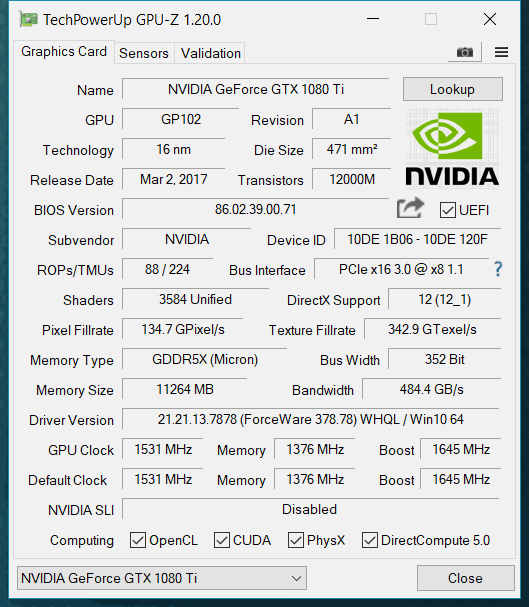
A GPU-Z screenshot provides the most pertinent technical information, even if the GPU Boost values we observed were higher than KFA2/Galax's official specifications.
| Header Cell - Column 0 | Nvidia Titan X (Pascal) | Nvidia GeForce GTX 1080 Ti FE | Galax GeForce GTX 1080 Ti EXOC | Nvidia GeForce GTX 1080 FE | Nvidia GeForce GTX 980 Ti |
|---|---|---|---|---|---|
| GPU | GP102 | GP102 | GP102 | GP104 | GM200 |
| CUDA Cores | 3584 | 3584 | 3584 | 2560 | 2816 |
| Base Clock Rate | 1417 MHz | 1480 MHz | 1531 MHz | 1607 MHz | 1000 MHz |
| GPU Boost Clock Rate | 1531 MHz+ | 1582 MHz+ | 1645 MHz | 1733 MHz+ | 1076 MHz+ |
| Memory Size and Type | 12GB GDDR5X | 11GB GDDR5X | 11GB GDDR5X | 8GB GDDR5X | 6GB GDDR5 |
| Die Size | 471 mm² | 471 mm² | 471 mm² | 314 mm² | 601 mm² |
| Process Technology | 16nm | 16nm | 16nm | 16nm | 28nm |
| Transistors | 12 billion | 12 billion | 12 billion | 7.2 billion | 8 billion |
| Streaming Multiprocessors (SM) | 28 | 28 | 28 | 20 | 22 |
| GFLOPS (Base Clock) | 10,157 | 10,609 | 10,974 | 8228 | 5632 |
| Texture Units | 224 | 224 | 224 | 160 | 176 |
| Texture Fill Rate | 317.4 GT/s | 331.5 GT/s | 342.9 GT/s | 257.1 GT/s | 214 GT/s |
| ROPs | 96 | 88 | 88 | 64 | 96 |
| Pixel Fill Rate | 136 GPix/s | 130.2 GPix/s | 134.7 GPix/s | 114.2 GPix/s | 116.7 GPix/s |
| Memory Data Rate | 10 Gb/s | 11 Gb/s | 11 Gb/s | 10 Gb/s | 7 Gb/s |
| Memory Bus | 384-bit | 352-bit | 352-bit | 256-bit | 384-bit |
| Memory Bandwidth | 480 GB/s | 484 GB/s | 484 GB/s | 320 GB/s | 336 GB/s |
| L2 Cache | 3MB | 2816KB | 2816KB | 2MB | 3MB |
| TDP | 250W | 250W | 250W (PT) | 180W | 250W |
Test System & Measurement Methods
We explained our test system and methodology in How We Test Graphics Cards. If you want to learn more about the procedures we're using in today's review, have a look at that story.
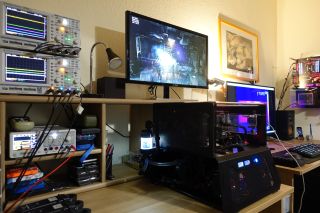
Since its publication, however, we did beef up our platform and CPU cooling, mostly to rule out the possibility of a processor-imposed bottleneck. This is particularly important given the flagship status of Nvidia's GeForce GTX 1080 Ti.
| Test Equipment & Environment | |
|---|---|
| System | Intel Core i7-6900K @ 4.3 GHzMSI X99S XPower Gaming TitaniumCorsair Vengeance DDR4-32001x 1TB Toshiba OCZ RD400 (M.2, System SSD)2x 960GB Toshiba OCZ TR150 (Storage, Images)be quiet Dark Power Pro 11, 850W PSUWindows 10 Pro (All Updates) |
| Cooling | Alphacool Eisblock XPXAlphacool Eiszeit 2000 Chiller2x be quiet! Silent Wings 3 PWM (Closed Case Simulation)Thermal Grizzly Kryonaut (Used when Switching Coolers) |
| PC Case | Lian Li PC-T70 with Extension Kit and ModsConfigurations: Open Benchtable, Closed Case |
| Power Consumption Measurement | Contact-free DC Measurement at PCIe Slot (Using a Riser Card)Contact-free DC Measurement at External Auxiliary Power Supply CableDirect Voltage Measurement at Power Supply2x Rohde & Schwarz HMO 3054, 500MHz Digital Multi-Channel Oscilloscope with Storage Function 4x Rohde & Schwarz HZO50 Current Probe (1mA - 30A, 100kHz, DC) 4x Rohde & Schwarz HZ355 (10:1 Probes, 500MHz) 1x Rohde & Schwarz HMC 8012 Digital Multimeter with Storage Function |
| Thermal Measurement | 1x Optris PI640 80Hz Infrared Camera + PI ConnectReal-Time Infrared Monitoring and Recording |
| Noise Measurement | NTI Audio M2211 (with Calibration File, Low Cut at 50Hz)Steinberg UR12 (with Phantom Power for Microphones)Creative X7, Smaart v.7Custom-Made Proprietary Measurement Chamber, 3.5 x 1.8 x 2.2m (L x D x H)Perpendicular to Center of Noise Source(s), Measurement Distance of 50cmNoise Level in dB(A) (Slow), Real-time Frequency Analyzer (RTA) Graphical Frequency Spectrum of Noise |
MORE: Best Graphics Cards
MORE: Desktop GPU Performance Hierarchy Table
MORE: All Graphics Content

TSMC's labor practices draw serious concern in Arizona — the company's new chip plant allegedly plagued by worker abuses

Former EKWB Employees say company has racist, hostile work environment, withholds overtime pay

Gigabyte confirms Ryzen 9000 branding for Zen 5 processors, preps beta BIOS updates for 500-series motherboards
-
sosofm A review about this 1080Ti http://www.kfa2.com/kfa2/graphics-card/hof/kfa2-geforcer-gtx-1080-ti-hof-le.htmlReply -
FormatC Reply
Just in work, stay tuned :)19861508 said:A review about this 1080Ti http://www.kfa2.com/kfa2/graphics-card/hof/kfa2-geforcer-gtx-1080-ti-hof-le.html
But in comparison with the dual-slot EVGA this solution is not worse. You can save a lot of money (and space), if you haven't such a big case. It is our job to show both sides of life - the Ferraris and the butter-and-bread cards. :)
-
Reply
You can tell just by looking at the pictures.19861700 said:Is it a blower design
Blowers have exactly 1 fan.
Blower fan blades are oriented such that the air will flow sideways.
Blowers have a casing that's designed to lead the air to the back of the card (out of the PC).
Not only does this card have 2 fans, the fan blade orientation clearly shows that the air will flow towards the card, and the casing is obviously open, which means the air isn't led anywhere.
So, no, it's not a blower design. -
Magnus Thunderson 2 HDMI 2.0 and 2 display ports would of been a much better choice but the I do not care as can not justify spending that much on a video cardReply -
photonboy Magnus Thunderson,Reply
I don't agree. I think 3xDP makes more sense. DisplayPort is becoming the standard for monitors, and people buying expensive GPU's may want a TRIPLE MONITOR setup with an HDMI left over for a BluRay playerThere are also OTHER configurations of cards for people who have different needs. -
2ndLastjedi I just got one of these GPU's, it sits at 2038 with a +136 on core @70c and can do +500 on memory but im concerned about the memory temps. Do you think the cooler solution is going to keep the memory at a safe temp with this OC?Reply
